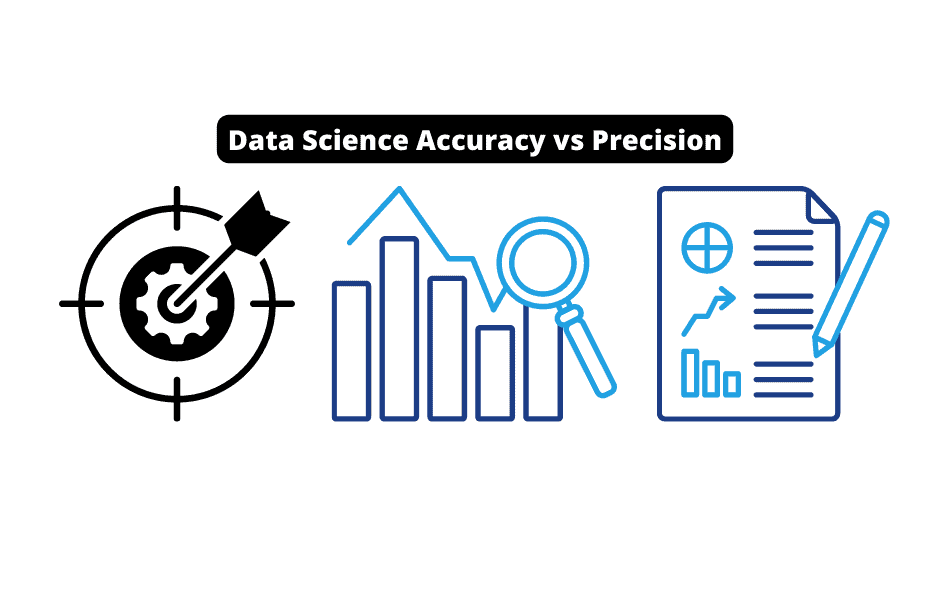Data science is a rapidly growing field that has become increasingly important in today’s world.
It involves using mathematical and statistical methods to extract insights and knowledge from (you guessed it) data.
A couple of key concepts in data science are accuracy and precision, and understanding the difference between these two metrics is crucial for achieving successful results during your modeling.
In general, if one class is more important than the others (like sick compared to healthy), precision and recall become more relevant metrics, as they’ll focus on the actionable events in the dataset. However, if all classes are equally important (classifying which type of car), accuracy is a good metric to focus on.
This article will dive deeper into exploring the meaning of accuracy and precision in data science and review scenarios where you should prioritize accuracy and others where you should prioritize precision.
While we understand that these topics can be overwhelming initially, you’ll be fully equipped with two new metrics in your toolbox to help YOU be a better data scientist.
You won’t want to miss this one!

Why Do Data Scientists Need Accuracy And Precision?
As data scientists, our primary goal is to build machine learning models that can predict outcomes, with some level of certainty, based on past data.
These models can be used for various tasks, such as classification, regression, and clustering.
To determine the success of our models, we need to evaluate them using various metrics.
And as you guessed, many different metrics are used to evaluate machine learning models, and two of the most well-known accuracy measures for classification problems are accuracy and precision.
Accuracy measures how well our model can correctly predict the class labels of our data set. This means it doesn’t care what it’s predicting, as long as it’s predicting it right (All data points are equal here).
Mathematically, It is calculated by dividing the number of correct predictions by the total number of predictions made.

On the other hand, precision measures the number of accurate positive predictions made by the model out of all positive predictions. It simply answers the question, what proportion of positive classifications are actually correct?
A model that can achieve a precision score of 1.0 produces no false positives, and a model that achieves a score of 0 has all false positives.
While they seem similar, accuracy and precision are essential metrics for data scientists to consider, as they help us answer different questions about the performance of our models.
For example, accuracy can give us an overall idea of how well our model performs, while precision can help us identify how our algorithm is doing on the “relevant” data.
While many believe a balance between accuracy and precision should be chased, this is only sometimes correct.
In the next section, we’ll review why sometimes these metrics can be misleading and how you can sometimes look at each of these individually to find the story that answers your business question.
Reference:
https://developers.google.com/machine-learning/crash-course/classification/precision-and-recall
Which Is Better, Accuracy or Precision?
When it comes to evaluating the performance of a machine learning model, the question of which metric is better, accuracy or precision, is asked all the time.
The answer, however, is more complex.
Neither metric is always better, as the relevance of each will depend on the specific business problem you are trying to solve.
For example, if you’re classifying things into four different categories with equal importance, accuracy might be a better metric for you.
This is because accuracy will give you an overall sense of how well you’re doing with your data and with classifying these objects into their respective categories.
In this scenario, a high accuracy score would indicate that your model correctly categorizes most of your data.
On the other hand, consider a scenario where you’re predicting medical disease from health data.
In this case, making too many positive claims when they’re untrue would be disastrous, as telling someone they have a disease when they do not is a dangerous and expensive event. Here, you would want to make sure your precision is in check.
In a situation like this, precision is more important than accuracy because it’s crucial to minimize false positive predictions.
It’s interesting to note that in some cases, even with very poor precision, the accuracy of a model can still be very high.
This is often because the amount of important events in the dataset is usually tiny.

Think about it this way, in the example above, your dataset would have a few positive medical diagnoses “1s” and many healthy individuals “0s”.
If your dataset was 95% “0s” and 5% “1s”, and your algorithm just predicted “0s” the whole time, it would achieve a 95% accuracy. However, this algorithm is not only useless – but dangerous to patients, as we would not be diagnosing the disease.
Be careful with blindly trusting any metric, as choosing the right one can actually be dangerous.
How to know when to use Accuracy, Precision, or Both?
Knowing when to use accuracy, precision, or both is an essential consideration for data scientists.
First, to get this out of the way, Precision and Recall are only used for classification algorithms, while accuracy can be used both for regression and classification.
As a quick review, recall measures the number of true positive predictions made by the model out of all actual positive instances. It is used in conjunction with precision to provide a complete picture of a model’s performance. (We’ll go over this more in another article).
In general, if one class is more important than the others, precision and recall become more relevant metrics, as they’ll focus on the actionable events in the dataset.
However, if all classes are equally important, accuracy is a good metric to focus on.
This is because accuracy provides an overall sense of the model’s performance, regardless of class label distribution.
In scenarios that fall somewhere between these two extremes, accuracy and precision should both be used to get a complete picture of the business scenario.
By considering both metrics, data scientists can build effective and reliable models while also considering the unique requirements of each business problem.

In Data Science, Can You Have High Accuracy But Low Precision?
It is possible to have a high accuracy score but low precision in data science.
This scenario is quite common, especially when working with unbalanced datasets that have a low number of important events (1s vs. 0s)
In such cases, focusing solely on accuracy can be dangerous and lead to misleading results.
This is because a high accuracy score can give a false impression that the model is performing well when it may be missing many important events.
If you find yourself in this scenario, it’s important to stop focusing on accuracy and instead focus on precision and recall.
By doing so, you can build a more relevant model to the goal you’re trying to achieve.
Precision and recall will give you a complete picture of the model’s performance (in this scenario) and help you identify areas for improvement.
Other Articles In Our Accuracy Series:
Accuracy is used EVERYWHERE, which is fine because we wrote these articles below to help you understand it
- Can Machine Learning Models Give An Accuracy Of 100
- How Can Data Science Improve The Accuracy Of A Simulation?
- Machine Learning Validation Accuracy
- High Accuracy Low Precision In Machine Learning
- What Is a Good Accuracy Score In Machine Learning?
- Machine Learning: High Training Accuracy And Low Test Accuracy
- How Much Does Motion Industries Pay Software Engineers? [Unlock Compensation Secrets] - October 28, 2025
- Mastering Logos Bible Software on iPad [Boost Your Bible Study!] - October 28, 2025
- Improving Software Fault Tolerance: Practical Strategies You Need [Boost Your Software’s Reliability!] - October 27, 2025

